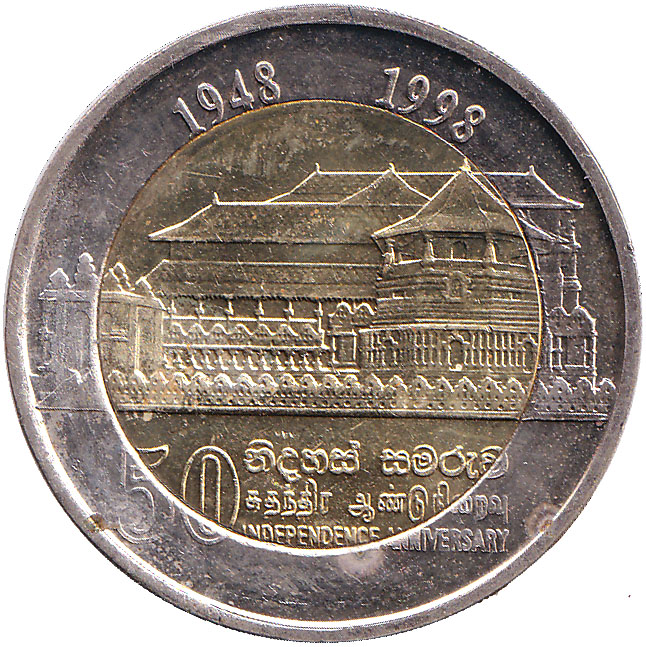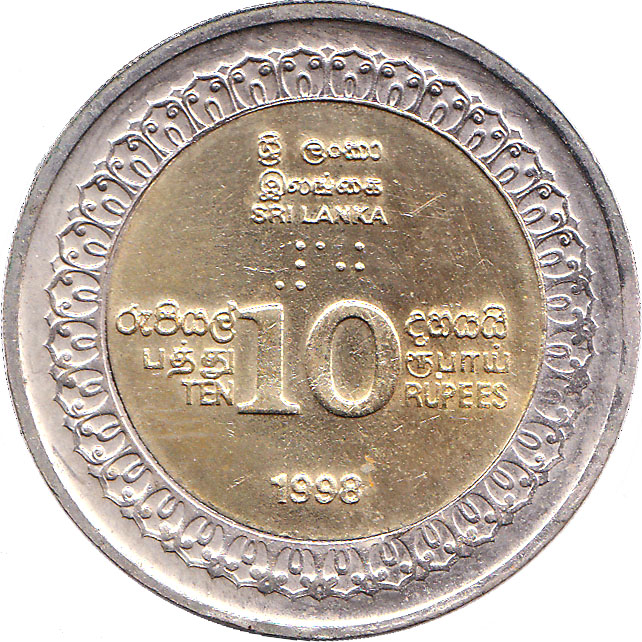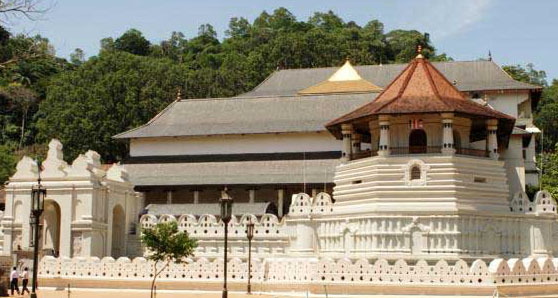| SPECIFICATIONS | |
| Denomination | Rupees Ten |
| Alloy | Cupro-Nickel |
| Nickel-Brass | |
| Diameter | 27.0/18.0 mm |
| Thickness | 2.2 mm |
| Weight | 9.0 gms |
| Shape | Round |
| Edge | Grained incuse lettering |
| Die-Axis | 0° |
| Issue | 50,000,000 |
| Mint | Royal,Wales |






|

|

| ||||||||||||||||||||||||

| ||||||||||||||||||||||||||
| KM# 158 | ||||||||||||||||||||||||||
Obverse : Across center overlapping both metals an image of the Dalada Maligawa in
Kandy with the Pattirippuwa (Octagon) in the forefront.
The period 1948 and 1998 above on either side.
Below image, the numeral 50 on left and the text to right side in 3 lines
නිදහස්
සමරුව
in Sinhala,
சுதந்திர
ஆண்டுநிறைவு
in Thamil,
INDEPENDENCE ANNIVERSARY. All within a raised rim.
Reverse : The large numeral denomination 10 at center dividing
රුපියල් දහයයි in Sinhala,
பத்து ரூபாய் in Thamil,
and TEN RUPEES and above the value in Braille.
Above the country name
ශ්රී ලංකා in Sinhala, centered on top with,
இலங்கை in Thamil
and SRI LANKA below in 3 lines.
Centered below and year of issue 1998.
All within circle of Petals around the inner metal within raised rim.
Edge : Grained with the incuse letters C B S L
four times only in English, as shown in image of right. Unlike the edge
of Rs 5 coin which has a dot after each letter and is listed in all
three languages Sinhala, Tamil and English.
The coin has been struck in Bi-metal. The 18 mm inner circle of the coin is Nickel-Brass and outer ring is in Cupro-Nickel.
The art work of the coins has been done by the Central Bank artist, Mrs Padmanjalee Karunatillake. The coins were minted at the Royal Mint, Wales, United Kingdom. It was issued to collectors in plastic coin sheets with 10 coins each. A Set of Ten uncirculated coins were issued to collectors sealed in plastic coin holder.
This Rs 10/- coin issued to general circulation is the first Bi-metal
coin from Lanka. There is worldwide Bi-metal
Collectors interest.
The Rs 10/- is also the first with Braille although I am not sure how
practical it is to read in the presence of all the other raised text.
In 2001 since the Rupees 10/- currency note was still in circulation
you saw it only infrequently in change.
The coin was put into circulation but is not seen very much. It seems that coins don't circulate well in parallel with currency notes of same denomination. In the USA the US$ coin doesn't with the $ note even after a lot of TV adverts and publicity. Now for the 2nd time a US$ a US$ coin has been abandoned after few years.
The mintage of 50 Million coins is far in excess for a commemorative coin. It was minted an attempt to replace the Rs10 note with a coin. This is like the 40 Million 1982 Rs 2 Mahawelli commemorative coins Minted after the Rs2 was stopped being printed with 1979 and before a regular Rs 2 issued in 1984. The Rs10 note only stopped with 2006 and regular Rs10 coin issued in 2009 was not Bi-metallic.
 The edge lettering which was only in English show 3 different
varieties. According to Mr W. M. K. Weerakoon of CBSL it was a single
large order. G.P.S.H. De Silva's book published soon after in 2000
August also mentions 50 million.
The lowest type shown on in image on left is seen on my set of 10
coins. It has vertical groves unlike the other two where the groves
are slightly tilted to the right and use a different Font. Must be
different Dies used in that large order.
The edge lettering which was only in English show 3 different
varieties. According to Mr W. M. K. Weerakoon of CBSL it was a single
large order. G.P.S.H. De Silva's book published soon after in 2000
August also mentions 50 million.
The lowest type shown on in image on left is seen on my set of 10
coins. It has vertical groves unlike the other two where the groves
are slightly tilted to the right and use a different Font. Must be
different Dies used in that large order.
This test trial 1995 Rs 2 coin sold at Stacks & Bowers Auction in 2021 June with PCGS certificate is attributed to King Norton Mint Collection. It appears to be one done for the edge lettering on the 1998 Rs 10 coin.
I thank David Mason of the Royal Mint Museum for replying my query in 2021 October confirming that 4.2% of the 50 Million coin order was subcontracted by the Royal Mint to IMI Birminham. This confirms the origin of the above IMI test trial.
On the apparent variations of edge shown above he states I quote the image depicted no variation beyond the slight level we might expect of a mass production process. The pressure applied during the edge lettering process can vary even within a production batch, and applying this pressure to a rounded piece of metal can cause some small variation in the shape or style of lettering where parts are impressed to a greater or lesser extent. Slight variation may also occur when the edge lettering tool becomes worn after extensive use; the bottom inscription on that web page appears to be an example of this kind of tool wear. It is also possible that the edge inscription on any given coin becomes worn down through the wear and tear of circulation.
One would need to statistically research a sample to estimate the apparent fractions or the three types illustrated, to see if one is about 4% and may be associated with IMI Issue. Edge was scanned at 2400 dpi and displayed at 800&dpi.
The coins were scanned at 300 dpi and the images are displayed at 254 dpi. The edge was scaned at 600 dpi and image is displayed at 508 dpi.
The CBSL leaflet on The History of Money describing this coin in the last sentence of the Text says The edge of this coin is milled with the letters CBSL in Sinhala, Tamil and English in incused lettering.. The author probably never looked at the coin. I find it strange to not have the Sinhala and Tamil lettering like the standard Rs 5/- coin particularly on this independence issue. The current officers of the central bank was surprised when I pointed out this discrepancy while meeting them in 2001 December.
The uncirculated Rs 10/- coin was obtained from the Central Bank of Sri Lanka. The 10-coin set in holder was purchased from a dealer in Colombo about 20 years later.
Media Report CDN 1998 02 06

